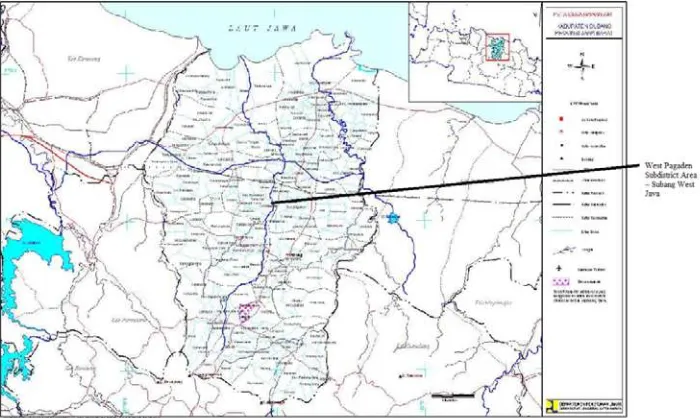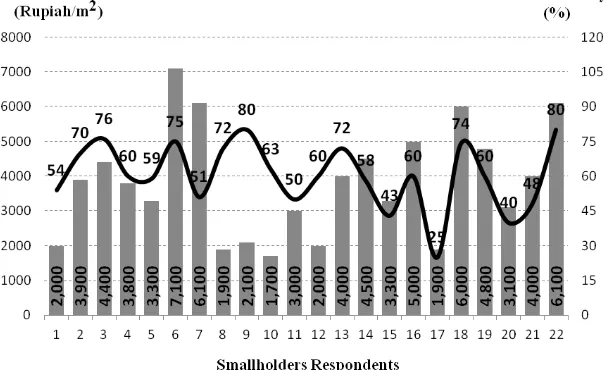RESILIENCY OF SMALL-SCALE COMMON CARP (Cyprinus carpio) FARMERS IN
WEST PAGADEN RURAL AREA OF SUBANG - WEST JAVA
(Daya Lenting Pembudidaya Ikan Mas (
Cyprinus carpio
) Skala Kecil di Perdesaan Kecamatan
Pagaden Barat Subang – Jawa Barat)
Carolina
*Pusat Pengembangan Teknologi Tepat Guna, Lembaga Ilmu Pengetahuan Indonesia
Jalan KS Tubun No 5. Subang 41214
*
Korespondensi. No Tel: 0260 412878. Fax 0260 411239. Email: carolina.4q@gmail.com.
Diterima: 2 November 2014
Disetujui: 28 Februari 2015
Abstract
Since early 1980s, freshwater fish farming was introduced as an economic activity to the rural
community in Subang, West Java Province. Until presently, 5% of the population participate on it,
specifically as common carp (
Cyprinus carpio
) cultivators in freshwater ponds ecosystem. The economic
gain from the carp farming triggers vast development indicated by significant landscape conversion from rice
fields to fish ponds. Environmental limitation does not seem to become their major concern, because good
yields which means good income is their main driving factor to extend and intensify common carp
aquaculture. Recognizing the important role of small scale fish farms in West Java common carp production
system, we explore their resiliency in confronting challenges encountered in managing the freshwater
ecosystem. Utilizing participatory observation and interview, we explore their socio-ecological resilience
from the perception of human and nature interaction. The study area is Pagaden Sub District in Subang -
West Java. Descriptive analysis is used to articulate the phenomenon enfolded in a socio-ecological
framework of thinking. It can be concluded that high dependency to the aquaculture activity, has reached a
situation in which ecologically sound technology should be introduced. Included in a scheme of technical
assistance which specifically designed to meet the need and in harmony with the socio-cultural characters of
small-scale fish farmers, the technology introduction should be carried out to spur the sustainable
aquaculture in Subang West Java. This should be a proposed agenda for the local government in support to
aquaculture sustainable development.
Keywords:
aquaculture ecosystem, common carp, ecology, environmental management, resiliency, rural
community.
Abstrak
Sejak awal tahun 1980, budidaya ikan air tawar diperkenalkan sebagai kegiatan ekonomi masyarakat
desa di wilayah Subang, Propinsi Jawa Barat. Dewasa ini, sekitar 5% populasi terlibat di kegiatan tersebut,
terutama sebagai pembudidaya ikan mas (
Cyprinus carpio
) di ekosistem kolam air tawar. Pendapatan yang
diperoleh dari kegiatan budidaya ikan mas telah memicu terjadinya percepatan laju pembangunan yaitu
dengan adanya perubahan lansekap dari petak-petak sawah menjadi kolam-kolam ikan. Keterbatasan
lingkungan tampaknya tidak dipertimbangkan, karena hasil panen yang tinggi atau keuntungan usaha
menjadi tujuan pokok perluasan atau pun intensifikasi kegiatan budidaya ikan mas. Mengingat peran
penting pembudidaya ikan skala kecil di rantai produksi ikan mas di Jawa Barat, kami melakukan kajian
terhadap daya lenting mereka dalam menghadapi tantangan mengelola ekosistem budidaya ikan air tawar.
Dengan memanfaatkan metoda pengamatan-partisipatif dan wawancara mendalam, data dan informasi dari
para pelaku budidaya ikan mas skala kecil di Kecamatan Pagaden Kabupaten Subang Jawa Barat ditelusur.
Analisis data dilakukan secara deskriptif untuk memberikan ruang artikulatif dalam mengurai fenomena
lapangan yang dirangkum dalam kerangka pikir sosio-ekologi. Dapat disimpulkan bahwa meskipun mereka
memiliki kearifan lokal tersendiri dalam membudidayakan ikan mas di kolam air tawar, ketergantungan
yang tinggi pada kegiatan akuakultur ikan mas, telah sampai pada situasi diperlukannya pengenalan
teknologi budidaya yang ramah lingkungan. Pengenalan teknologi tersebut seyogyanya disertai strategi
pendampingan yang sesuai dengan kebutuhan dan karakter sosial-budaya para pembudidaya ikan mas skala
kecil. Hal ini perlu dijadikan agenda pemerintah daerah untuk diterapkan demi keberlanjutan pengelolaan
ekosistem akuakultur di Subang – Jawa Barat.

